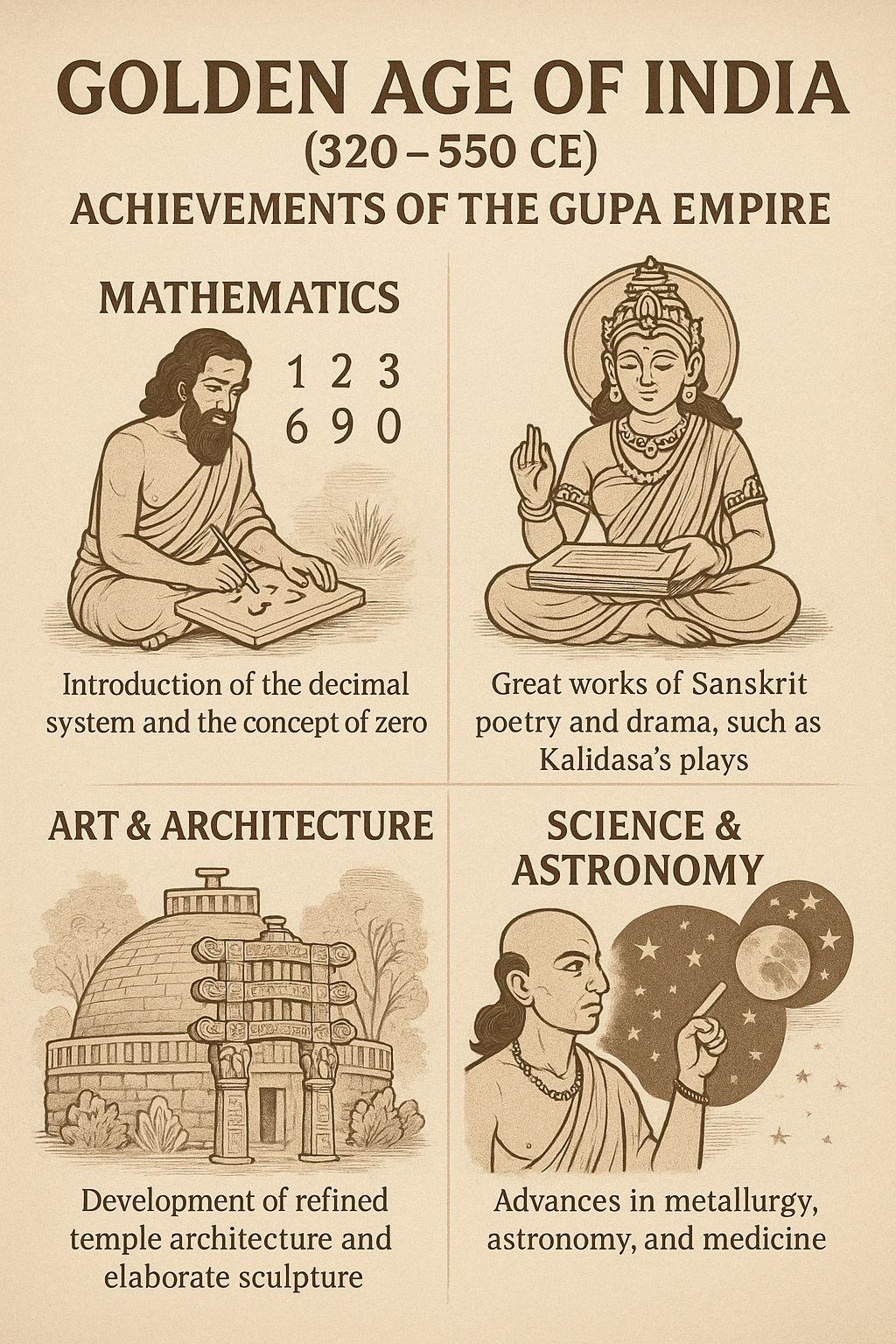Golden Age of India (320–550 CE): Achievements of the Gupta Empire Discover its achievements in arts, architecture, sculpture, literature, mathematics, astronomy, medicine, and trade. Learn about Kalidasa, Aryabhata, Nalanda University, Ajanta paintings, and the lasting legacy of one of India’s most remarkable eras. Read more on Smart Bharat Manch.
Introduction
The Gupta Empire (320–550 CE) is often hailed as the Golden Age of India (320–550 CE), a period of extraordinary achievements in governance, economy, arts, science, mathematics, and literature. Under the leadership of rulers like Chandragupta I, Samudragupta, and Chandragupta II (Vikramaditya), India witnessed political stability, cultural prosperity, and intellectual brilliance.
The Guptas encouraged scholars, scientists, and artists, establishing India as a center of global learning. This era laid the foundation for many modern concepts in mathematics, astronomy, medicine, and literature.
For a more detailed look at the Gupta Empire, visit: Gupta Empire – Golden Age.
Rise of the Gupta Empire
Founded by Sri Gupta around 320 CE, the Gupta dynasty expanded rapidly under:
- Chandragupta I – Consolidated smaller kingdoms and formed strategic alliances through marriage.
- Samudragupta – Known as the “Napoleon of India,” he expanded the empire through military conquests and diplomacy.
- Chandragupta II (Vikramaditya) – Strengthened political stability, promoted trade, and patronized arts and education.
The Guptas established trade networks connecting India to Rome, China, and Southeast Asia, facilitating economic growth and cultural exchange (Wikipedia).
Related Internal Links:
- Education focus in Gupta era → MAHA TET Exam Guide 2025
- Early Indian trade and civilization → Indus Valley Civilization: Urban Planning, Seals, Arts, and Religion
- Rivers and agriculture context → Saraswati River and Mauryan Archaeological Discoveries
Arts in the Gupta Period-
Architecture
Gupta architecture laid the foundation for Hindu temple architecture. Notable examples include:
- Dashavatara Temple, Deogarh – One of the earliest temples with intricate carvings.
- Udayagiri Caves – Rock-cut temples dedicated to Vishnu.
The shikhara (temple spire) became prominent, influencing subsequent Indian temple styles.
- Temple art and architecture concepts → Indus Valley Civilization Architecture
Sculpture
Gupta sculptures are known for grace, serenity, and spiritual expression. Mediums included stone, bronze, and terracotta.
- Seated Buddha from Sarnath – Exemplifies calm and spiritual balance.
Internal link reference:
- Sculpture and arts in Indian history → MAHA TET Exam 2025 Notes: Art & Culture Section
Painting
Ajanta Caves frescoes are among the finest examples of Gupta painting. They depict:
- Jataka Tales – Stories of Buddha’s previous lives
- Court Scenes – Life of royalty and nobles
- Nature – Animals, plants, and landscapes
Gupta paintings are praised for vivid colors, elegance, and realistic detail (HistoryDiscussion).
- Indian painting heritage → LIC Golden Jubilee Scholarship 2025 – Art & Culture Section
Science and Technology
Mathematics
Gupta period marked significant advances in mathematics:
- Aryabhata – Introduced the concept of zero, place-value system, π approximation, and trigonometric calculations. Proposed that Earth rotates on its axis.
- Brahmagupta – Expanded on algebra, arithmetic, and negative numbers.
Internal link reference:
- Indian mathematical heritage → MAHA TET Exam 2025 – Math & Science Notes
- Zero and place-value system → Saraswati River Civilization and Knowledge Systems
Astronomy
Aryabhata’s astronomical theories revolutionized knowledge:
- Predicted solar and lunar eclipses
- Studied planetary motion
- Explained Earth’s rotation
Observatories and scholarly research were encouraged during Gupta rule. (Wikipedia)
Medicine-Golden Age of India (320–550 CE)
Medical science flourished:
- Charaka Samhita – Ayurveda texts detailing diseases and treatments
- Sushruta Samhita – Surgical techniques and instruments
Hospitals and medical schools thrived, emphasizing systematic healthcare.
Internal link reference:
- Ancient Indian medicine → MAHA TET 2025 – Health & Education Notes
Metallurgy-Golden Age of India (320–550 CE)
Iron Pillar of Delhi – 7 meters tall, rust-resistant over 1600 years, reflects advanced metallurgy.
- Metallurgy and engineering → Indus Valley Civilization Technology
Literature and Education
Sanskrit Literature
The Gupta period is the classical age of Sanskrit literature:
- Kalidasa – Abhijnanashakuntalam, Meghaduta, Raghuvamsha
- Amarasimha – Amarakosha, a Sanskrit thesaurus
- Puranas – Compiled in their present form
- Sanskrit literature & arts → MAHA TET Exam 2025 Notes – Literature Section
Education
Renowned centers: Nalanda and Takshashila
- Subjects: Grammar, logic, medicine, mathematics, astronomy, philosophy
- Students: Scholars from Central Asia, China, Southeast Asia
- Ancient Indian universities → MAHA TET Exam 2025 – Education Notes
Economy and Trade
Agriculture formed the backbone of the Gupta economy.
- Trade – Connections with Rome, China, Southeast Asia
- Products – Spices, silk, gold, and silver
- Coinage – Gold and silver coins reflected prosperity and craftsmanship
- Ancient Indian trade & economy → LIC Golden Jubilee Scholarship 2025 – Economic Context
Legacy of the Gupta Empire-Golden Age of India (320–550 CE)
| Field | Contribution |
|---|---|
| Arts | Temples, Ajanta paintings, sculpture excellence |
| Science | Concept of zero, astronomy, metallurgy |
| Literature | Kalidasa’s works, Sanskrit classics |
| Education | Universities like Nalanda and Takshashila |
| Economy | Flourishing trade, gold coinage |
The Gupta Empire left a lasting impact on Indian civilization.
Conclusion
The Gupta period truly represents a Golden Age of India (320–550 CE):
- Arts – Ajanta frescoes, temple sculpture
- Science – Mathematics, astronomy, metallurgy
- Literature – Kalidasa’s poetry, Sanskrit classics
- Education – Nalanda, Takshashila
- Economy – Flourishing trade and coinage
Gupta achievements established the cultural, educational, and scientific foundations of India, leaving a legacy that continues to inspire scholars, artists, and scientists globally.


1 thought on “Golden Age of India (320–550 CE): Achievements of the Gupta Empire”